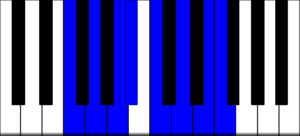Jazz Piano – 7-3-6 (minor 2-5-1) Lick
You can approach the creation of a jazz piano lick over a 7-3-6 or minor 2-5-1 chord progression just as you would for a 2-5-1 lick in a major key. You can use
-
- chord tones
- arpeggios
- triplets
- a line that moves up and down
- approaches to chord tones.
Here is an example for a lick using these elements that you can use whenever you come across a minor 2-5-1.

-
- The first bar consists of notes that are just moving up and down the F major (or D minor) scale, starting on the flatted fifth of the Em7b5 chord, Bb.

The F major scale

-
- The last Ab is an approach to the following A, which is the beginning of an arpeggiated A minor 7 chord. The line then moves down again diatonically. The bar ends with another approach.
- This time it moves to the root D of the following Dm7 chord. What follows is a small rhythmical motive with two eighth notes followed by one quarter note, moving down the diatonic scale again. The lick ends on D.
[...]
Jazz Piano – 2-5-1 Lick 1
Because the 2-5-1 is used so much in jazz music, your improvisation can be a lot easier, if you know a few licks that you can play over this segment, ideally in [...]
Rock Piano Soloing
Rock Piano – Fast Sixteenth Notes
Knowing some basic chord shapes can unlock many possibilities. One is to play chord tones as fast sixteenth notes. The effect is great, while the playing is rather simple.
A rock piano solo pattern with arpeggios
In the following example, just move the same chord shape up and the keyboard [...]

